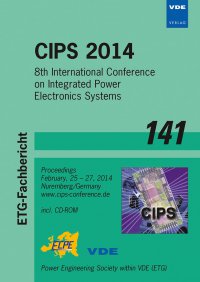Challenges on Diagnostics of Power Electronics Modules and Assemblies
Konferenz: CIPS 2014 - 8th International Conference on Integrated Power Electronics Systems
25.02.2014 - 27.02.2014 in Nuremberg, Germany
Tagungsband: CIPS 2014
Seiten: 6Sprache: EnglischTyp: PDF
Persönliche VDE-Mitglieder erhalten auf diesen Artikel 10% Rabatt
Autoren:
Albrecht, H.-J.; Busche, N.; Strogies, J.; Wilke, K. (Siemens AG, CT RTC ELE PME-DE, Siemensdamm 50, 13623 Berlin, Germany)
Schuster, M.; Cassigniol, C. (Siemens AG, CT RTC MAT ANA-DE, Siemensdamm 50, 13623 Berlin, Germany)
Inhalt:
Due to a higher integration level and power losses, standard packaging of power electronic modules is further approaching its electrical and thermal limitations. One possible alternative solution for common solder and bond wire interconnects is the silver sintering technology processed at low temperatures. As the applications of power semiconductors have continuously increased, suitable substitutes for high-temperature high-lead solders are required. The low temperature joining technique (LTJT) has been proposed as a possible alternative to lead-free die attach materials and high temperature application as mentioned above. There are numerous benefits associated with the use of Ag particles in LTJT. Silver has better thermal and electrical conductivities than the commonly used Sn–Pb or Sn-Ag-Cu joints. nano-/micro-Ag joints are sintered at temperatures significantly lower than the melting temperature of Ag, typically in the range of 0.2–0.4 (0.37 at T = 250°C). Once sintered the Ag joint will have a melting temperature similar to bulk Ag (961°C). This property will avoid any problems in the power electronic packaging and assembly processes as well as in the field of application (wind power, industrial drive technologies, automotive sector). The paper will address the discussion of interconnect formation as well the discussion related to acceptance criteria of high-temperature die attach and substrate attach in power applications. Basics are the preconditions for a successful interconnect formation in terms of roughness, warpage, top- and bottom side metallization, contamination behavior of sinter paste, desorption properties, etc. of the die and the DCB itself. In relation to any description of experimental setups, analytical data will be discussed to classify interfaces and stable interconnects. One important point is the definition of acceptance criteria for the sintering process. Destructive and non-destructive evaluation tools will be highlighted to identify micro- and/or macro-defects in combination with electrical and thermal requirements. Results of the electrical and thermal behavior, the link to the bonding strength, the damage characteristics and first reliability features will be presented.


